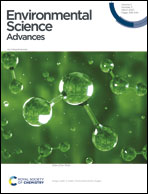Silylation: a reproducible method for characterization of non-extractable residues (NER) of organic chemicals in the assessment of persistence†
Abstract
Most, if not all, chemicals, biocides, pharmaceuticals and pesticides are known to produce non-extractable residues (NER) in solid environmental media like soil and sediment during degradation testing to various extents. Since it has been found that parent substances and relevant metabolites can be contained and potentially released from NER there is currently much debate on how to include NER in the environmental persistence assessment. Using radioactive or stable isotope labelled test substances, three types of NER can be experimentally discriminated: entrapped, sorbed or heavily sorbed (type I) having the potential to be released from the matrix. Type II NER, i.e. residues covalently bound to organic matter in soils or sediments, are being considered to have very low remobilisation potential. Type III NER (bioNER) are formed after degradation of the xenobiotic chemical and incorporation into natural biomolecules (anabolism) like amino acids and other biomass compounds, and are, thus, of no environmental concern. Silylation has been suggested as a methodology to differentiate types I and II NER but concern has been addressed that this procedure is not suitable for routine analysis, e.g. in the context of studies for authorisation and registration of chemicals. Here, we describe a readily applicable and reproducible experimental procedure to apply this method for the analysis of NER derived from bromoxynil, sulfadiazine and isoproturon, respectively. This method is able to distinguish between heavily sorbed and covalently bound residues of chemicals, biocides, pharmaceuticals and pesticides in soils and to subsequently identify residues of the parent substance entrapped in type I NER.

- This article is part of the themed collections: Topic Collection: Sensors, Detection and Monitoring and Environmental Science: Advances – Editorial and Advisory Board Member Publications


 Please wait while we load your content...
Please wait while we load your content...